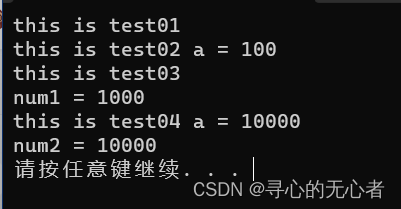1、函数定义
#include <iostream> using namespace std;int add(int num1, int num2) {int sum = num1 + num2;return sum; }int main() {system("pause");return 0; }
2、函数的调用
#include <iostream> using namespace std;int add(int num1, int num2) {int sum = num1 + num2;return sum; }int main() {int a = 10;int b = 20;int sum = add(a, b);cout << sum << endl;system("pause");return 0; }
3、值传递
#include <iostream> using namespace std;void swap(int num1, int num2) {cout << "交换前" << endl;cout << "num1=" << num1 << endl;cout << "num2=" << num2 << endl;int temp = num1;num1 = num2;num2 = temp;cout << "交换后" << endl;cout << "num1=" << num1 << endl;cout << "num2=" << num2 << endl; }int main() {int a = 10;int b = 20;swap(a, b);cout << "a=" <<a<< endl;cout << "b=" << b << endl;system("pause");return 0; }
4、函数的常见样式
#include <iostream> using namespace std;//1、无参无返 void test01() {cout << "this is test01" << endl; }//2、有参无返 void test02(int a) {cout << "this is test02 a = " << a << endl; }//3、无参有返 int test03() {cout << "this is test03" << endl;return 1000; }//4、有参有返 int test04(int a) {cout << "this is test04 a = " << a << endl;return a; }int main() {//无参无返的函数调用test01();//有参无返的函数调用test02(100);//无参有返的函数调用int num1=test03();cout << "num1 = " << num1 << endl;//有参有返的函数调用int num2=test04(10000);cout << "num2 = " << num2 << endl;system("pause");return 0; }
5、函数声明
#include <iostream> using namespace std;int max(int a, int b);int main() {int a = 10;int b = 20;cout << max(a, b) << endl;system("pause");return 0; }int max(int a, int b) {return a > b ? a : b; }
6、函数的分文件编写
函数分文件编写一般有4个步骤
1.创建后级名为.h的头文件
2.创建后缀名为.cpp的源文件
3.在头文件中写函数的声明
4.源文件中写函数的定义
swap.h
#include <iostream> using namespace std;void swap(int a, int b);swap.cpp
#include "swap.h"void swap(int a, int b) {int temp = a;a = b;b = temp;cout << "a = " << a << endl;cout << "b = " << b << endl;}main.cpp
#include <iostream> using namespace std; #include "swap.h"int main() {int a = 10;int b = 20;swap(a, b);system("pause");return 0; }
函数(个人学习笔记黑马学习)
本文来自互联网用户投稿,该文观点仅代表作者本人,不代表本站立场。本站仅提供信息存储空间服务,不拥有所有权,不承担相关法律责任。如若转载,请注明出处:http://www.mzph.cn/news/59769.shtml
如若内容造成侵权/违法违规/事实不符,请联系多彩编程网进行投诉反馈email:809451989@qq.com,一经查实,立即删除!相关文章
【DRONECAN】(三)WSL2 及 ubuntu20.04 CAN 驱动安装
【DRONECAN】(三)WSL2 及 ubuntu20.04 CAN 驱动安装
前言
这一篇文章主要介绍一下 WSL2 及 ubuntu20.04 CAN 驱动的安装,首先说一下介绍本文的目的。
大家肯定都接触过 ubuntu 系统,但是我们常用的操作系统都是 Windows&#x…
C++------map和set的使用
文章目录 关联式容器键值对树型结构的关联式容器set的介绍map的介绍 关联式容器
什么是关联式容器?它与序列式容器有什么区别? 关联式容器也是用来存储数据的,与序列式容器不同的是,其里面存储的是<key,value>结…
【拾枝杂谈】从游戏开发的角度来谈谈原神4.0更新
君兮_的个人主页 勤时当勉励 岁月不待人 C/C 游戏开发 Hello,米娜桑们,这里是君兮_,结合最近的学习内容和以后自己的目标,今天又开了杂谈这个新坑,分享一下我在学习游戏开发的成长和自己的游戏理解,当然现在还是一枚…
【LeetCode75】第三十九题 二叉树的右视图
目录
题目:
示例:
分析:
代码: 题目: 示例: 分析:
题目给我们一棵二叉树,让我们返回站在二叉树右边从上到下看到的节点。
那实际上就是要我们对二叉树进行层序遍历,…
js判断对象是否为空对象的方法总结
js判断对象是否为空对象的方法总结 方法1:JSON.stringify()方法方法2:for in方法方法3:Object.keys()方法方法4:Object.getOwnPropertyNames()方法方法5:jquery 的 isEmptyObject()方法 在面试或者开发过程中ÿ…
effective c++ 笔记
TODO:还没看太懂的篇章 item25 item35 模板相关内容 文章目录 基础视C为一个语言联邦以const, enum, inline替换#define尽可能使用constconst成员函数 确定对象使用前已被初始化 构造、析构和赋值内含引用或常量成员的类的赋值操作需要自己重写不想使用自动生成的函…
108页石油石化5G智慧炼化厂整体方案PPT
导读:原文《108页石油石化5G智慧炼化厂整体方案PPT》(获取来源见文尾),本文精选其中精华及架构部分,逻辑清晰、内容完整,为快速形成售前方案提供参考。以下是部分内容,
Deepin添加Ubuntu源
升级Deepin V23后,无法安装Zeal了,后面发现可以通过ubuntu源来安装。参考了以下两个文档。
添加Ubuntu源1
添加Ubuntu源2
1.添加ubuntu.list
sudo vim /etc/apt/sources.list.d/ubuntu.list
2.添加中科大Ubuntu源
deb http://mirrors.ustc.edu.cn/…
Kafka监控工具,LinkedIn详解
Kafka监控工具包括以下几种: Kafka Manager:这是一个开源的Kafka集群管理工具,可以监控Kafka集群的健康和性能,并提供可视化的用户界面。 Kafka Monitor:这是LinkedIn开发的一个监控工具,可以监控Kafka集群…
PKI/CA体系介绍
概述
目前最常用的第三方认证服务包括:PKI/CA和Kerberos。PKI/CA是基于非对称密钥体系的,Kerberos是基于对称密钥体系的。 数字证书:提供一种发布公钥的简便途径; 数字签名:用来确认信息发送者的身份,保证…
win11出现安全中心空白和IT管理员已限制对此应用的某些区域的访问
问题 windows安全中心服务被禁用 winr 输入services.msc 找到windows安全中心服务查看是否被禁用,改为启动,不可以改动看第三条 打开设置,找到应用—windows安全中心–终止–修复–重置 重启如果还是不行看第四条 家庭版系统需要打开gped…
设计模式大白话——命令模式
命令模式 一、概述二、经典举例三、代码示例(Go)四、总结 一、概述
顾名思义,命令模式其实和现实生活中直接下命令的动作类似,怎么理解这个命令是理解命令模式的关键!!!直接说结论是很不负责…
【设计模式】Head First 设计模式——桥模式 C++实现
设计模式最大的作用就是在变化和稳定中间寻找隔离点,然后分离它们,从而管理变化。将变化像小兔子一样关到笼子里,让它在笼子里随便跳,而不至于跳出来把你整个房间给污染掉。 设计思想
桥模式。将抽象部分(业务功能)与实现部分(平…
Mysql B+数索引结构
一、B树和B树区别
二、 B 树形成过程
三、页分裂过程
3.1 页分裂过程实例
3.1.1 原有数据1、3、5形成如下数据页 3.1.2 先新插入数据4,因为 页10 最多只能放3条记录所以我们不得不再分配一个新页: 新分配的数据页编号可能并不是连续的,也…
iOS逆向:越狱及相关概念的介绍
在上一篇内容中我们介绍了App脱壳的技术,今天我们来介绍一个和iOS逆向密切相关的知识:越狱。
iOS操作系统的封闭性一直是开发者们关注的焦点之一。为了突破Apple的限制,越狱技术应运而生。本文将深入探讨iOS越狱,包括可越狱的版本…
【C语言】每日一题(除自身以外数组的乘积)
添加链接描述,链接奉上 方法: 暴力循环:前缀积后缀积(分组): 暴力循环:
暴力循换真的是差生法宝,简单好懂,就是不实用,大多数的题目都会超过时间限制(无奈)
思路&…
一个简单的Python网络爬虫教程
网络爬虫是一种自动获取网页内容的程序,它可以从互联网上的网站中提取数据并进行分析。本教程将带您逐步了解如何使用 Python 构建一个简单的网络爬虫。
注意:在进行网络爬虫时,请遵守网站的使用条款和法律法规,避免对目标网站造…
嵌入式Linux开发实操(十五):nand flash接口开发
# 前言
flash memory,分NAND和NOR: 如果说nor flash有个特点就是能执行代码,NOR并行接口具有地址和数据总线,spi flash更是主要用于存储代码,SPI(或QSPI)NOR代码可就地执行(XiP),一般系统要求flash闪存提供相对较高的频率和数据缓存的clocking。而nand flash主要用于…
SpringCloud学习笔记(九)_使用Java类加载SpringBoot、SpringCloud配置文件
我们都知道平常在使用SpringBoot和SpringCloud的时候,如果需要加载一两个配置文件的话我们通常使用Value(“${属性名称}”)注解去加载。但是如果配置文件属性特别多的时候使用这种方式就显得特别的不友好了。 比如说,我们要加载下方这个名为application.…
大数据之linux入门
一、linux是什么
linux操作系统
开发者是林纳斯-托瓦兹,出于个人爱好编写。linux是一个基于posix和unix的多用户、多任务、支持多线程和多CPU的操作系统。
Unix是20世纪70年代初出现的一个操作系统,除了作为网络操作系统之外,还可以作为单…






WSL2 及 ubuntu20.04 CAN 驱动安装)














)

:nand flash接口开发)
_使用Java类加载SpringBoot、SpringCloud配置文件)
